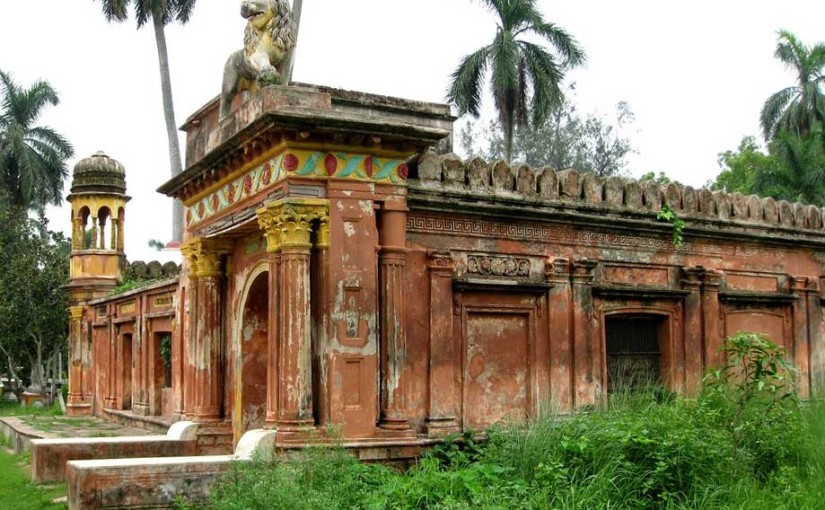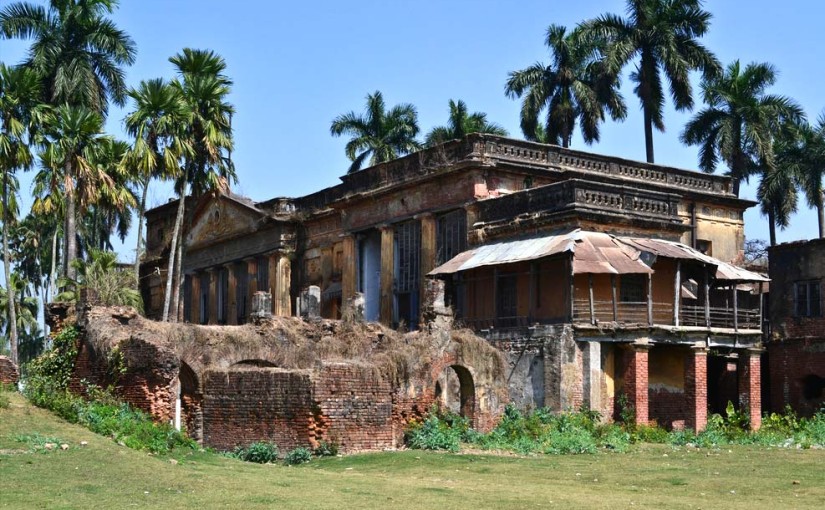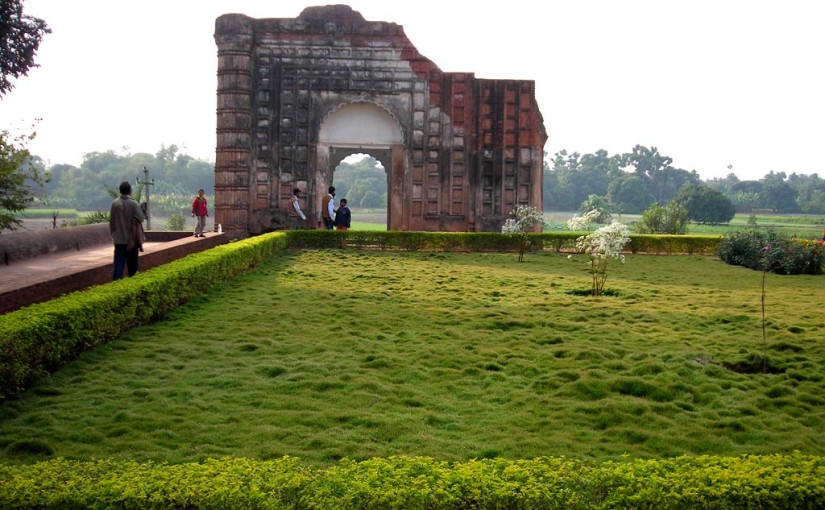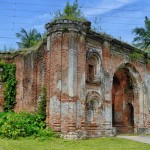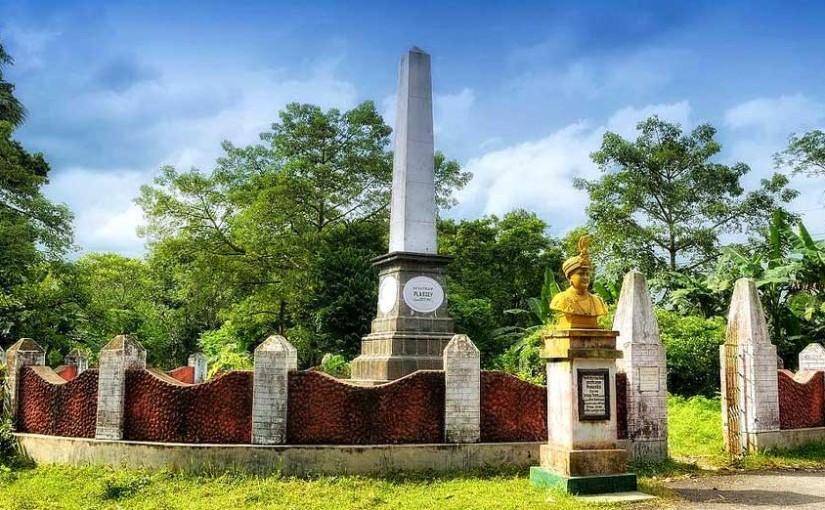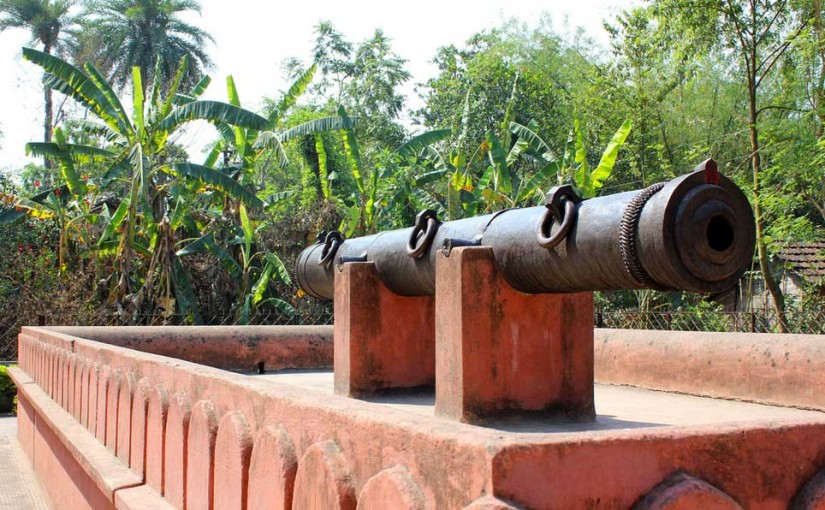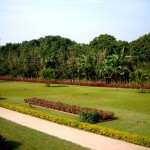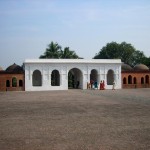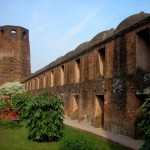Footi Mosque or masjid as it called in Urdu is an unfinished work of Nawab Sarafaraz Khan. It is located at a distance of a mile from Hazarduari Palace. Though unfinished the mosque has some unique architectural features that attract tourists to this spot. It is said that Sarafaraz Khan built this structure in one night.
Tag: Katra Mosque
Kathgola Palace, Murshidabad
The Kathgola Palace built in the garden premises of Raja Dhanpat Singh Dugar and Lakshmipath Singh Dugar is located in half a km South-East part of Mahimapur (modern Nashipur) town in Murshidabad. It is an impressive structure constituting a central drawing room, a library, billiard room, bedroom and dining room. Built during 1870s as a rest house amidst the garden it has porches on all 4 sides. The pool sides are beautiful providing natural ventilation. The fantastic view of the countryside from the second floor will mesmerize you. Also there is the Adinath Temple which is of immense importance to the Jains.
Image Source: Flickr
Nasipur Palace, Murshidabad
According to Holiday HotSpot, Nasipur Palace, old name Mahimapur Raj Bari is one of the primary attractions of Murshidabad which generally brims with visitors. Constructed in 1723-24 by Murshi Quli Khan this imposing structure has high minarets, huge domes and also a cemetery of the Nawab just below the staircase. Ramachandra Temple, one of the largest temples in Murshidabad is inside the palace compound. The Nasipur Palace is only 1.5kilometers from the Railway station on the Berhampore-Lalgola route.
Image Source: Flickr
Nimak Haram Deori, Murshidabad
Nimak Haram Deori is the main gate leading to Mir Jafar, the traitor’s palace Jafargunj. It is located at a distance of only 1 kilometer north from the magnificent Hazarduari. Visitors cannot enter into the palace as it is well guarded. This palace stands as the memorial of the darkest hour in the history of Bengal as Nawab Siraj-ud-Daulah was killed here in an act of the betrayal. This assassination was decisive in the colonization of Bengal and India.
Photo Courtesy: Tarun Pradhan, Flickr/Rajib Kumar Bhattacharya
War Memorial at the Battle of Plassey Ground, Murshidabad
The battle ground of Plassey lying on the banks of the Bhagirathi River holds lot of historical significance. The British East India Company defeated the last independent Nawab of Bengal Siraj-ud-Daulah in the Battle of Plassey on 23 June 1757 which decided the fate of Calcutta and India. The British built the war memorial in the same year and the statue of The Nawab was erected by West Bengal government in the recent times. Mir Jafar, the commander-in-chief of the Nawab’s army betrayed him by accepting bribe from Lord Clive sealing the fate of slavery for Indians for the next 200 years.
Image Source: Flickr
Mosque at Khoshbag Cemetary, Murshidabad
This mosque is located inside the premises of Khoshbag which is the final resting place of the Nawabs belonging to the Afshar dynasty ruling Bengal. It has the tombs of Nawab Siraj-ud-Daulah, his wife, grandfather and grandfather’s mother. Located on the west bank of Bhagirathi River, this is a famous toursist spot.
Cemetery of Siraj-Ud-Daula (Khoshbag ), Murshidabad
The cemetery of Siraj-ud-Daulah or Khoshbag as it is popularly known as is located at the Bhagirathi River bank in the west. The tomb is also shared by his wife, Lutf-un-nisa and his grandfather, Alivardi Khan. Basically Khoshbag is home to the tombs of Nawabs from the Afshar dynasty. Khoshbag covers an area of 7.65 acres of land. This is a prime holiday hotspot and thus secures a permanent place in other listings on the most notable tourist attractions in Murshidabad.
Moti Jheel near Lalbagh, Murshidabad
Moti Jheel, literal meaning Pearl Lake is a charming horseshoe shaped lake located 1 kilometer south of Lalbagh. The land adjoining Moti Jheel witnessed the celebration of Lord Clive after he acquired Bengal, Bihar and Orissa in 1765. It was also home of Warren Hatings during his tenure as Political President at Nawab Nazim’s durbar in 1771 AD. Moti Jheel is also referred to as the ‘Company Bagh’ because it was occupied by East India Company for a long time. Holiday HotSpot has also found out that the only existing building in the area is the Shahamat Jang.
Following are the other leading spots within Mitijheel:
[row]
[column lg=”4″ md=”4″ sm=”4″ xs=”12″ ]
Ruins of Mitijheel Palace
[/column]
[column lg=”4″ md=”4″ sm=”4″ xs=”12″ ]
Motijheel Mosque
[/column]
[column lg=”4″ md=”4″ sm=”4″ xs=”12″ ]
Motijheel Cemetery
[/column]
[/row]
Jahankosha Canon near Katra Mosque, Murshidabad
Jahankosha canon also known as the Great Gun, exactly means the “Destroyer of the World” weighing 16,880 lb is 17.5 feet long with a girth of 5 feet at the touch hole end. The diameter of the touch hole is 1.5 inches and the diameter of the orifice is 6 inches. The celebrated canon is located at a short distance of 1 kilometer from Katra and was constructed in the 17th century by a craftsman named Janardan Karmakar belonging to Dhaka. There is a mosque named Kadam Sarif close to the canon which is said to house the replica of Hazrat Mohammad, the Prophet’s footprint.
The cannon is maintained by the Archaeological Survey of India.
Image Source: Flickr
Mursidabad Katra Mosque: A Must See for History Buffs!
Being a resident of Kolkata, West Bengal, I have always preferred Murshidabad as a convenient weekend getaway. Quite contrary to my friends who unfailingly sneaked in to the over explored seas of Digha, I made it a point to make short trips to Murshidabad on short holidays. Here, I would like to speak about my experience of witnessing one of its famous buildings- the Katra Mosque. It is located around 3 km east of the historical city (i.e. Murshidabad) and around 200 kms from Kolkata.
The Mursidabad rail station is nearby as well (Katra Mosque situated at 1.5 kms–north-eastern part of the station). Built between the year 1723 and 1724 by Nawab Murshid Quli Khan, this building served as an important centre of Islamic learning.
History of Katra Mosque
The mosque derives its name “Katra” from the bustling market place that surrounded it. Katra means marketplace. It is place where Nawab Murshid Quli Khan had been buried. The earthquake of 1897 had considerably destroyed this mosque, believed to be the replica of Kartalab Khan’s mosque in Dhaka (built in around the year 1700-1704 AD).
- Katra Masjid Garden, Murshidabad
- Katra Masjid can accommodated around 2000 Namaz readers
- Katra Mosque, Inside
Structure
The Archaeological Survey of India has made sure that the remains of this important structure are well cared for. The main gate would lead you to a massive courtyard that is believed to have accommodated around 2000 Namaz readers at the same time! There are huge domes and two minarets standing at 70 feet. The other two minarets are believed to have been destroyed by the quake. Each of the domes had these semi-circular patterns (Mihrabs) in the wall that point towards the Kabba in Mecca. (Climbing a good 67 steps (22 meters) up you will find 2 of the surviving pillars from which you can take a considerable view of the surroundings. each on the terrace. There are two pillars with 15 meter radius. The other pillars, here, have been destroyed).
The mosque is replete with intricate designs and stretches across a whopping 40*71/2 metres. You can only wonder at the overwhelming grandeur of this structure. The huge door embracing the entrance has some Iranian words written on it. The writing extols the Muhammad of Arab. Sarfaraj Khan’s Futi Masjid is placed at the west of the Katara Mosque at the edge of the railway line. This one replicates the Katara Mosque. The Topkhana is a castle, situated at the south eastern side of Katara.
Interesting Facts about Katra Mosque in Murshidabad
It is claimed that an individual named Farash Khan was assigned the task of building this mosque. He, apparently, was not very fond of Hindus and had built the masjid using materials collected after destroying Hindu temples. This one served as the residence of 700 Quran readers. There are no wooden panels on the ceilings here.
How to Reach the Katra Mosque
- Murshidabad Railway Station Junction is the nearest railway station near the Katra Masjid. They are set just a kilometer apart.
- The Jiaganj railway Station is around 6.7 km away
- The Beldanga Railway Station is around 28.3 km
- Train would be a safer and more convenient means of travel here, as the nearest airport (i.e. Rajshahi Airport) is 34 km away!
In fact reaching Murshidabad from Kolkata or Howrah is very easy as a lot of trains are available.
When Should You Visit this Place?
It is ideal to avoid the scorching summers while you’re heading for Murshidabad. Target the time between October to February. The temperature hovers around the 20s (hardly rising above it) thus providing you the much needed respite from the humid summers. The mosque is open for visitors on all days between 5-6 pm.
Accommodation
There is no dearth of cheap hotels around the Masjid. The fact that there is a wide array of 3, 4 and 5 star hotels present in and around the mosque, substantiates the claim that it is one of the most oft-visited places in Murshidabad.
The nearest place to stay, however, would be WBTDC’s Raiganj Tourist Lodge. The price would vary around INR 500- INR 1000 per night.
Image Source: Tarun Pradhan
